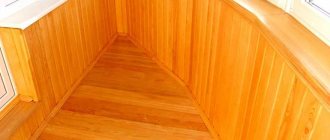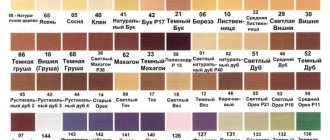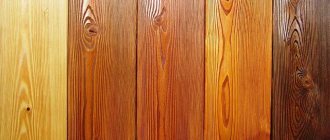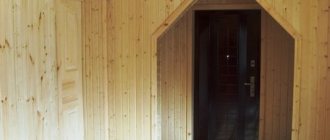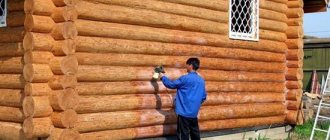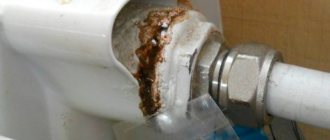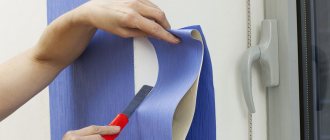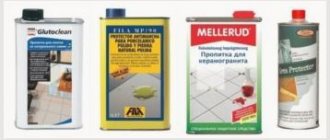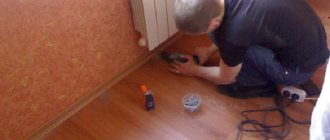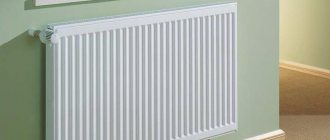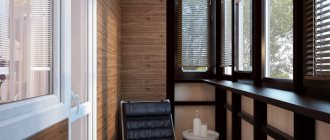At the same time, it is a very vulnerable material that has low resistance to weathering, temperature changes and humidity. It burns well and is a breeding ground for many pests and their larvae, fungal bacteria and their spores.
Parts of wooden structures and finishing can turn into dust inside in a very short time, and become covered with mold on the outside.
Lining - protection features
To avoid all these troubles, it is necessary to consistently and competently subject wooden parts to special treatment and apply protective coatings.
As for the lining, which is used to cover balcony rooms, after a short time, under the influence of ultraviolet radiation, it begins to acquire a dark shade and loses the naturalness of the internal wood pattern.
As protective measures, the lining with which the balcony is lined must be treated using:
- primers;
- impregnation;
- varnishes;
- paints
Step-by-step instruction
Preliminary work - cleaning, grinding nicks.
A prepared surface is the key to a high-quality protective coating
The work consists of several stages:
- The lining must be dry - there is no point in applying a protective coating to a wet surface.
- The wood may crack slightly as it dries. The next step is to seal the cracks that have arisen.
- Sand the surface, remove the smallest chips - bring the surface to perfect condition.
- Finally, clean the walls from dirt and accumulated dust.
Before coating, the lining must be prepared
If the lining was previously treated with protective agents, remove them completely. Make a special solution - dilute a package of soda in 10 liters of hot water. The presence of mold or discoloration requires an additional bleaching procedure using ready-made products.
The next step is to treat the surface with an antiseptic. Apply the composition and leave to dry for a day.
Now you can start covering the lining with varnish, paint or impregnation. Apply the first thin coat evenly using the tools indicated earlier. After complete drying, the surface may become somewhat rough in some places - go over them with a special construction sandpaper to remove it.
The final stage is to cover the lining with a second layer of protective coating.
Myths and misconceptions
Looking through materials on the Internet about protective coatings for wood products, linings in particular, you can find a lot of articles in which, to put it mildly, not everything corresponds to reality.
It seems that the authors have never in their lives encountered the topic they are covering.
The most common misconception or myth is the mention of antiseptics in the same category as primer mixtures and compositions for impregnating wood.
Let's start with the fact that antiseptics are only one of the components that impregnation or deep penetration primer includes. First you need to understand what a primer is and how it differs from impregnation.
The main difference is the depth of penetration into the wood fibers.
As a rule, impregnating compositions are intended for:
- increasing the fire resistance of wood by changing the internal structure of the material in such a way that under the influence of an open fire it does not ignite, but begins to smolder without forming an additional source of fire, or lights up, but after a certain time has passed, which can be used to suppress the fire;
- transforming wood fibers from a breeding ground for pests and bacteria into a material in which they can neither develop nor reproduce, which prevents the tree from rotting and internal destruction.
To perform these tasks, all impregnations have the property of penetrating deep into the core of wooden parts and have antiseptic and anti-feather components as components, thus providing comprehensive protection from the inside.
The primer provides surface protection of wood from moisture penetration into the fibers, as well as protection from ultraviolet radiation and the penetration of insect pests.
It has a wood processing depth of only a few millimeters, forming the necessary outer protective layer. It also contains antiseptic components, but its main purpose is to prepare the application of the final protective layer in the form of varnish or paint.
At the same time, depending on the component on which the varnish or paint will be made, primers can be:
- alkyd;
- acrylic;
- emulsion;
- epoxy;
- polyurethane.
It should not be denied that the retail chain offers a variety of impregnations that have exclusively antiseptic properties, while providing only biological protection for the tree. In the price lists they are called antiseptics, although they are in the impregnations section.
The next misconception is more dangerous.
When describing the sequence of operations for applying protective coatings, in the vast majority of articles everything begins with the phrase: “After installing the lining...” and further in the text.
It turns out that having bought the lining, it is immediately installed and then processed. Of course, for dry rooms, apartments, offices, saunas, and also where large areas are covered with clapboard, this is consistently justified.
However, in relation to a balcony that is only thermally insulated and which does not have a constant climate regime, and by all building standards belongs to rooms with high humidity, this approach is unacceptable if the goal is to obtain a durable finish for the walls and ceiling.
The whole point is that when treating the lining with protective compounds after installing it on the balcony, they forget that in addition to the facade, there is also a back side, and it remains untreated.
It’s good when the lining fits tightly to the heat-insulating material, but fresh lining, which is mainly made of pine, has high residual moisture and the heat insulator is simply not designed to prevent the appearance of fungus on the wet surface of the wood.
It’s like with carpets, you look at it - it’s beautiful, but you take it off the wall, and there’s horror, both on the carpet and on the wall. A similar situation occurs with the lining on the balcony.
To avoid such a situation, after the delivery of the lining it is necessary to sand it, remove dust from the surfaces, treat it with a completely complex impregnation containing both antiseptics and fire retardants, put it in a pile on the same balcony and give it time to absorb and dry.
Some types of impregnations add special compounds that reduce the drying time of the composition to 7 hours. In this case, it is better to choose impregnations with a natural period of penetration and drying to allow the protective components to penetrate as deeply as possible into the wood fibers.
How to properly paint the inside of the lining: technology
To paint lining in “dry” rooms inside the house, you can use any type of paint. Here you simply decide on the requirements for the decorative appearance of the surface. If the lining is dry, it can not be impregnated with protective compounds, or you can choose paint/varnish/wax with appropriate additives. You can paint it only on one side, leaving the back side untreated.
Paint each panel of the lining separately
If the lining will be used in damp or unheated rooms, on a balcony, it must first be thoroughly impregnated with protective compounds on all sides, maybe twice. Only after the impregnation has dried can it be painted, varnished, or, in general, given decorative properties. Another point: when installing the lining on a wall or ceiling, it has to be cut into pieces. Places of cuts in damp rooms must also be coated with the composition. It is not necessary to wait until it dries, but it is necessary to process it.
There is one very important nuance that many amateur decorators overlook. If you want to get a professional-level painting of the lining, you need to process each board separately: sand, paint, dry, and only then assemble the surface from the already painted lining. That is, mount already fully processed boards on the wall or ceiling. Only with this approach will the surface of the lining have the same color from any point.
It’s difficult to paint the entire surface of a clapboard wall well
If you paint an already assembled surface, unpainted areas remain in the grooves and recesses, making it difficult to sand large areas. You definitely won't get a perfectly flat surface. The quality of finishing in this option is not above average. It is permissible to paint a finished surface if you are renewing the paint job. This must be done at different intervals, depending on the operating conditions and the properties of the paintwork material.
Correctly, the painting technology looks like this.
- The lining is checked and sorted. All bent, bent or cracked boards are rejected. They can be used to test color, select color, number of layers, practice technique and painting sequence.
- Boards that have been sorted are sanded until completely smooth. It is most effective to work with a sanding machine, but you can also use a block with sandpaper attached to the surface. Sandpaper grit - 250-280. When grinding, circular movements pass through the face, tenon and groove. The back part of the lining can be left without treatment.
- Apply the composition with a roller or brush. Each type of coating has its own points and features - they are written on the can or in the accompanying instructions. In general, the rules are simple: take a little paint and apply it in single strokes along the entire length of the lining. Then rub thoroughly and shade until a uniform color is obtained.
- Having achieved uniform coloring, leave to dry.
- After drying, sand again if necessary. This step is often necessary when working with opaque paints and varnishes. The first layer of paintwork raises the pile of the wood, which is why it becomes rough in places. This pile is removed by repeated sanding.
- The second layer of paintwork is applied. Drying.
There can be many layers: it depends on the hiding power of the paint and on what effect you want to get. But in any case, one rule remains: there should be little composition on the brush. The exception is impregnation or primer. They are applied with a well-moistened brush, but only those without pigment. When applying pigmented protective compositions, the rules for paints apply - the minimum required amount of the composition is well shaded.
Sometimes, even with careful rubbing of the paint, stains are clearly visible. This is not a bad paint, but the properties of wood: in some places the pores absorb better, in others worse. In order to achieve an even color in this case, the surface is first primed. You can use any wood primer or colorless matte varnish (can be water-based). After drying, the surface is sanded (yep, again) and then the required number of layers of paint are applied. Only in this case, after the first layer of paintwork, grinding is rarely required, and if necessary, then in some places, more often on a tenon or groove.
Watch the video to see how to evenly apply glaze, oil or wax.
If furniture quality painting is required, there are even more layers: first a stain is applied, then two layers of primer. After drying, the surface is sanded until the surface is completely matte, first with grain 280, then 320, after removing the dust, a finishing layer is applied - varnish. An example of such work is in the video.
Types of protective varnishes and paints
After the lining has been treated with impregnation and installed, you can begin to apply a primer and the main protective coating - varnish or paint.
Before choosing a primer, you need to decide what the lining will be coated with to ensure compatibility of the bases.
To cover the lining on the balcony, the following types of varnishes are used:
- for glazed and insulated balcony rooms, the best budget option would be water-based varnish;
- varnishes with an acrylic base provide increased water resistance and UV protection;
- a durable protective film on the lining is obtained by using alkyd varnish, but you need to be prepared for the fact that it has a strong odor and a long drying time, up to 24 hours, which is a long time compared to water-based varnishes with their 3 hours .
There is also a varnish for lining based on polyurethane. It is intended for external work, is frost-resistant, moisture-resistant and perfectly preserves the natural color of the wood from fading under the influence of sunlight.
But it is very toxic, and when working with it it is necessary to use personal protective equipment - gloves and a mask with a filter (not gauze).
Paints for covering lining are used quite rarely, only when it is necessary to give the surface of the lining a color in accordance with the design style of the interior.
They also resort to painting the lining when it is necessary to hide obvious defects in the appearance of the lining - chips, cracks or knots. All this is first puttied and cleaned.
Experts recommend using either oil-based or water-based paint for lining. When applying 3-4 layers, the defects disappear and the surface of the lining becomes smooth.
Lucky
If you decide to apply varnish to the lining, it is important to know that the resulting coating may differ in its chemical and physical characteristics. The determining factor in this matter is the basis of the composition.
- Aquatic. The main advantage of such compounds is their safety. Environmentally friendly materials used in production provide the coating with hypoallergenic properties, an almost complete absence of characteristic odor and other advantages.
Among the disadvantages, we can note certain restrictions on their use, which are associated with the fact that the aqualac coating is not resistant enough to the direct effects of an aggressive external environment, therefore varnishes of this type are recommended to be used only for painting the internal cladding made of this material on a glazed balcony or loggia.
- Alkyd. In contrast to the previous option, this varnish can be used in almost any room and in any climatic conditions, since after painting the lining, a water-repellent film forms on it. This is especially valuable for areas with high humidity levels. It is also worth noting that thanks to the film, the level of impact resistance of the coating increases.
Among the disadvantages, it is worth noting the strong smell of the varnish and the excessively long drying period.
- Acrylic. Provide the skin with good protection from direct exposure to ultraviolet radiation and moisture. They do not contain harmful volatile components, that is, they are absolutely safe. Acrylic varnishes are inexpensive and come in a wide range of colors. Before use, the product must be diluted with essential alcohol or water until the required consistency is obtained. The composition is applied in two layers: the first is protective, and the second is necessary to obtain the desired shade of finish. It can be used both outside and inside the balcony. The varnish layer dries quickly.
- Polyurethane. It is intended exclusively for external painting of lining. It concentrates the important advantages of varnishes on other bases: moisture and frost resistance, effective protection against UV radiation, quick drying, long service life.
However, as noted above, polyurethane varnish is only suitable for exterior cladding, given its toxicity and specific odor.
For reference!
When performing finishing work, protective equipment is used, for example, a respirator, or, in the absence of one, a thick gauze bandage.
Criteria for choosing varnish for various rooms
Varnish for wooden panels must meet the following parameters:
- water resistance, which will protect the lining from deformation and the formation of fungus and mold;
- resistance to mechanical stress and ultraviolet radiation;
- have antiseptic properties, that is, provide protection against all kinds of parasites and microorganisms;
- wear resistance, which ensures durability of the lining.
However, when choosing varnish for different rooms, you should take into account their features:
- The best option when finishing interior cladding from lining is aqualaks, since they do not pose any danger to people or animals. True, they are absolutely not suitable for rooms where the level of moisture is high, such as the bathroom or kitchen. The finishing on the balcony is covered with a double layer of aqualak: the first one functions as an antiseptic, the second layer is decorative.
- Painting lining in a country house primarily plays a protective role. First of all, it protects the coating from direct sunlight and ultraviolet exposure. Acrylic varnish is considered the most suitable option for these conditions.
- When processing wall cladding in a bathhouse, compounds are used that are able to withstand extreme temperatures. Synthetic options are not suitable for solving these problems, since under “bath” conditions they will release toxic harmful substances. For such cases, paint and varnish compositions whose main components are natural oils are more suitable. They will maintain the natural balance of the room.
Useful little things
- It is preferable to eliminate minor defects before varnishing using homemade putty from a mixture of sawdust that remains after cutting the lining panels with PVA glue. After the glue has dried, the putty will not differ in color from the color of the walls.
- As already noted, to emphasize the texture of the wood, tinted varnishes are used, which makes the lining pattern more expressive. As an alternative to these varnishes, the panels can be pre-treated with stain.
- When painting lining in two layers, panels with the first layer of paint or varnish that has already dried must be sanded. If this is not done, the sheathing will be rough to the touch, since when the wood is moistened, fine pile rises on its surface.
- When choosing a varnish, give preference to compositions containing a so-called UV barrier, since the wood in these areas darkens when exposed to direct sunlight.
Tool
To carry out paint and varnish work, you will need the following tools, which are best prepared in advance.
Although many sites claim that paint can be applied to the lining using a paint roller or sprayer, the most convenient tool, and most importantly one that will ensure high-quality coating, is a brush.
It is best to purchase separate sets of brushes for each type of protective composition. This will free you from the need to wash the brush after impregnation for the primer, and from the primer for varnish or paint, and thereby not only improve the quality of the work, but also reduce the time it takes to complete it.
If all the rules for the protective treatment of the lining are observed, it can retain its original appearance without repair or restoration work.
Source: remont-na-balkone.ru/remont-i-otdelka/chem-pokryit-vagonku-na-balkone.html
Tips and tricks for painting and more
- If the walls of the balcony room are not monochromatic, try to combine up to three different color shades at the same time. Black and white colors are not taken into account.
- Paints of dark shades and tones are not suitable for balconies and loggias on the sunny side. Dark walls, absorbing solar energy, will quickly heat up. If the air temperature at this time is significantly lower than the heated wall, then there is a high probability of condensation.
- For exterior painting of the balcony, choose colors that match the facade of the building.
- Weather also affects the quality of painting work. In case of rain or high humidity, the paint takes a very long time and does not dry evenly. Rain drops on the fresh paint on the outside of the balcony can ruin the appearance and mood of the owners of the balcony. In hot weather, the paint sets very quickly and does not have time to spread evenly over the surface.
- It is advisable to tint the primer for the main paint to match the color of the topcoat. After such preparation, areas with a thinner layer of paint will not stand out.
- During the painting process, it is convenient to paint different areas of the surface with different tools. Therefore, it doesn’t hurt to have rollers, a spray bottle and brushes of different sizes on hand.
- Before work, you need to make sure that the color or tone of the paint matches your idea of the final result. To do this, paint is applied to a small area of the surface. When it dries, you can make a final conclusion about compliance.
- The quality of the painting is indicated by the uniformity of color on the painted surface. This is not difficult to achieve. To ensure that the consistency of the working material is uniform and that dye particles do not settle to the bottom of the container over time, the paint must be thoroughly mixed not only before application, but also periodically during operation.
- It is recommended to purchase the necessary paint, primer and varnish from one manufacturer. Such materials are fully compatible, which will have a positive effect on the quality of painting work.
- Remember to use masking film and masking tape to protect adjacent surfaces from being painted.
- When painting brick and concrete walls, it is better not to use oil-based paints. Not being a vapor-permeable material, they cause unwanted moisture accumulation. The result of high humidity is damage to the wall material by microorganisms and its premature destruction.
- The ends of wooden lining require very careful treatment with preparatory compounds and paint.
The right choice of paint, high-quality preparation of the surface for work and careful painting will allow you to forget about updating the balcony walls for a long time. All that remains is to switch to other things. You can now relax on the balcony rather than work.
Subscribe
HelpfulUseless
Choosing the composition and rules for processing lining on the balcony?
Long gone are the days when mini pantries were installed on balconies (and for some, not mini ones at all). Nowadays, a cozy and beautiful balcony is, first of all, a place for rest and relaxation.
So let's talk about bringing our balcony into a cozy oasis of our home. The first point will, of course, be covering the wall with clapboard. This material is ideal for covering balconies and loggias, as well as for decorating gazebos, facades and much more. Well, after covering the walls, the question arises: how to cover the lining on the balcony?
Description of the painting process
To make it easier for you to understand the topic, we have divided it into 2 parts:
- Preparatory activities;
- Applying paint.
Both steps are simple, but require some knowledge. Therefore, carefully read all the information below in order to thoroughly understand the topic and carry out the work efficiently.
Colors can be combined if desired
Stage 1 – preparation
As part of this stage, a number of activities need to be carried out:
- Measurements. First, the area of all surfaces to be finished is measured, this is necessary in order to calculate the approximate paint consumption. Typically, from 100 to 150 grams of composition are used per square meter, the specific figure depends on the density of the surface and its preparation;
- Choice of composition. It is best to use compositions based on acrylic or alkyd. They are highly durable; a thin moisture-proof film is formed on the surface, which protects the material well;
- Color selection. You also need to decide on the color; if the varnish for the lining on the balcony gives the surface a certain shade, then the paint completely covers the structure. This allows you to achieve any desired effect;
Related article: Design of a long kitchen with a balcony
Everyone will find the optimal shade for themselves, the range is very large
Important! When buying paint, always buy with a small reserve, so that you don’t end up with just a little bit of paint left unpainted.
- Puttying. If there are significant unevenness and cracks on the surface, be sure to purchase putty. It can be any color, but the surface will still be stained and the repair areas will not be visible. Please note that a different technology is used inside the sauna;
It is also better to choose an acrylic-based composition for repairs.
- Surface preparation begins with cleaning it and a general assessment of its condition. If there are stains on the surface from bitumen or other difficult-to-remove compounds, they must be removed with special means;
- If there is damage to the lining, then it must be puttied. To do this, take a narrow steel spatula, apply a small amount of the compound on it, and all irregularities are carefully sealed. Remove excess putty immediately so that you don’t have to spend a long time removing it with sandpaper;
It is most convenient to carry out puttying work before painting with a narrow spatula
- Grinding. After the composition has dried, it is necessary to level the surface in the repair areas to perfect condition. To do this, take sandpaper with a grain no larger than P240. You can work either manually or using a special grater, it all depends on the volume of work;
- If necessary, poorly treated areas in other places are sanded; the better the lining is prepared, the better the final result will be;
Fine sandpaper quickly removes all surface imperfections
- Cleaning from dust. After sanding, be sure to clean the surface from dust. This is done with a brush or broom, but it is best to take a vacuum cleaner and go through it. It is important to remove fine wood dust so that when painting it does not spoil the surface;
- Application of primer. Before painting the lining on the balcony, it is necessary to apply primer to the surface. Any composition based on acrylic or alkyd that can be used for wood is suitable for the job. Just apply it in a thin layer without smudges and wait for the surface to dry completely (this takes from 2 to 12 hours).
The primer reduces the absorption of the base and improves paint adhesion
Stage 2 – painting
Instructions for doing the work yourself look like this:
- Mix the solution. First you need to open the package of paint and mix it thoroughly. During storage, individual components settle, and if the composition is not stirred, the coating will be uneven;
- We dilute to condition. If the consistency is too thick, then a solvent or water is added to the composition, which is suitable in your case, depends on the type of paint used, all information is on the label. See Tikkuril's article for lining;
Important! Remember that paint can be applied at temperatures from +5 to +30 degrees. Air humidity should not be high.
- Working with a brush. For work, use a brush with thick, long bristles. The composition is applied along the wood fibers. This method of distributing the composition allows you to get rid of streaks and reduces the likelihood of smudges. It is best to work from top to bottom, so you can easily remove smudges even when they occur;
Apply paint carefully. Smudges greatly spoil the appearance of the lining
- Drying. Next, you need to wait until the composition dries completely, this takes from a couple of hours to a day, depending on the temperature. The second layer is applied in a similar way; it provides more reliable surface protection. It is important to be careful here, as flaws cannot be removed.
If you have a spray gun, you can use it. This application option provides more even coverage. But when working, you need to use protective equipment to avoid inhaling fine dust.
Painting with a spray gun is done in a respirator
Material properties
What is a lining? This is a wooden board intended for covering and finishing walls. This material has quite a few advantages over other types of finishing coatings:
- good thermal insulation;
- will last for many years;
- excellent sound insulation;
- maintains optimal room humidity;
- it is relatively inexpensive.
However, there is one small drawback. Since lining is a natural material, external factors such as moisture, microorganisms, and temperature changes cause rotting processes in it. This problem can be easily solved by choosing the right coating product.
When choosing lining, it will not be superfluous to decide on the manufacturer. There are both our and European manufacturers of lining. The difference is in price and some nuances. Domestic lining is cheaper, European lining is much more expensive, but is of higher quality. What to choose is, of course, up to you.
When choosing materials for finishing balconies and loggias, you should not forget about the type of wood from which the lining is made. It is best to choose coniferous species such as pine or larch.
Since the essential oils contained in them are an irreplaceable natural antiseptic that prevents wood from rotting. Linden, ash or oak, which are classified as deciduous trees, are also perfect.
Technology of competent work execution
Using even the best composition does not guarantee a good result if the technology for its application is not followed. We start with a careful inspection of the cladding, especially if it is painted and needs to be repaired. We sand the coating that has become unusable, remove cracks and chips. If darkening or traces of mold appear, they need to be bleached with peroxide or oxalic acid. You can correctly calculate the proportions of ingredients taking into account the type of wood.
After bleaching, be sure to rinse the product clean. We clean the sanded base from sawdust and fine dust. It is best to wash it with soapy water. After drying, apply a suitable antiseptic. Let it dry. If you need to treat not only the walls, but also the floor, we do the same.
It is optimal to carry out painting work on a warm, windless day, so the product will dry evenly. On a glazed balcony, open the windows to ventilate the room. Pour the product into a suitable container, stir it well and begin application. We start painting from the corner, then move along the perimeter. If the room has shelves or a storage box, we paint them too.
You can work with a spray gun, brush or roller. The first option gives the best result, but its implementation requires special equipment. Therefore, it is easier to order such processing from specialists. You usually apply the drug yourself with a roller or brush. Apply the first layer, wait until it dries, and sand the base. Re-paint the surface.
Choosing the right lining product is not difficult. This must be done taking into account future operating conditions. A properly selected coating reliably protects the cladding from moisture, temperature changes and other adverse effects, significantly extending its service life.
Required tools and materials
When starting to cover the lining, it is necessary to choose a material that meets all the requirements: it is safe for others, durable, preserves and emphasizes all the beauty of the wood ornament.
So far, the ideal coating has not yet been invented, but we can still try to achieve the result we need. So how to cover the lining on the balcony?
First of all, you should use bioprotective compounds, in other words, antiseptics. They come in two types:
- By impregnating the wood, they preserve its natural structure. These are translucent or glaze impregnations;
- By saturating the wood, the pattern becomes almost invisible, and only the relief remains. These are opaque antiseptics.
However, one layer of impregnation with an antibacterial agent is not enough; it is necessary to consolidate the result by creating a top protective layer. The lining boards should be treated with such compounds before they are used to cover the surface of the balcony or loggia.
As soon as the impregnation has dried, you can begin decorating. Now let’s look at how to treat the lining on the balcony after the antiseptic?
The following materials are suitable for decoration:
Paint or varnish is applied using continuous movements from top to bottom, which will ensure uniform coloring of the entire board.
Having chosen the material, you should also take care of the tools. To work, we need two plastic basins of different sizes, gloves, rollers of different sizes, plastic film, brushes, sponges.
Advantages and disadvantages of painting lining
Painting the lining with enamel or colorless varnish can extend the life of the material. If the board is used for covering walls and work surfaces in a utility room, you can get by with regular impregnation. In a house or apartment, it is better to paint wood paneling with high-quality paint for practical and decorative purposes. After all, replacing a damaged top layer of wood is much more expensive than several cans of enamel. You can purchase a ready-made painted board or paint it yourself. Coating panels with your own hands has many advantages:
- Possibility of coloring elements in different colors, applying your own design, texture;
- Saving money. Treated lining is much more expensive;
- Possibility to choose the most incredible shade;
- Increasing resistance to negative external factors;
- Quick drying.
There are practically no disadvantages to painting lining. The main negative point is the loss of the natural pattern and appearance of the wood. Some negative consequences can be avoided if you take into account the purpose of the room when choosing a paint and varnish material. Oil impregnation and drying oil are not suitable for baths and saunas. It is better to use solid mixtures with the addition of wax. It is not recommended to use flammable, toxic enamels for painting wooden boards in closed, unventilated areas. Painting lining floors should be carried out taking into account the abrasion of the material. To avoid having to repaint frequently, you should choose mixtures with high wear resistance.
General recommendations
The weak point of the lining is its joints, so it is necessary to apply several layers of primer at the joints.
You can also try the waxing technique - this is coating the lining with hydrophobic wax. It can be purchased at a specialized store or made at home yourself.
It is best to process lining on the balcony in dry, warm weather. When covering a balcony or loggia, do not forget about the rest of the interior of the apartment, so that everything together looks harmonious and beautiful.
Source: kraska.guru/specmaterialy/zashhita-drevesiny/chem-pokryt-vagonku-na-balkone.html
Lining or eurolining?
The prefix “euro” is not just a figure of speech; behind the words are hidden important technological characteristics based on compliance with the quality standards of profiled boards. The European standard is considered more stringent, as it regulates, among other things, the radius of workpieces and careful surface treatment. If the required level of humidity according to Russian GOST can be achieved by atmospheric drying, then the European standard can only be achieved by forced drying in special chambers.
| type | standard | humidity, % | height, mm | spike, mm |
| eurolining | European DIN 68126 | 8 – 12 | 12.5 | 8 |
| lining | Russian GOST 8242-88 | 18 — 25 | 15 – 18 | 4 — 6 |
A distinctive feature of eurolining is additional compensation grooves (grooves) on the back side, which prevent deformation of the lamella during seasonal fluctuations in humidity and temperature. This makes eurolining the optimal choice for finishing a balcony.
In addition, the lining is made with different profiles; its choice is complete freedom and purely a matter of taste.
How to treat the lining on the balcony? Our tips are here
When renovating apartments, many people are interested in how to cover the lining on the balcony. This question is really important.
Lining is a special board made of wood. It is used to carry out interior finishing work on a balcony or loggia. It can also be useful for the external arrangement of the facade of a building.
The popularity of lining is constantly growing, because this material is very convenient for construction and repair. It has many advantages.
How to choose the “right” composition
The decisive factor in choosing the right substance should be the conditions under which the cladding will be used. Despite the fact that the balcony is located on the facade of the building, it cannot be clearly attributed to the external premises. If glazing is installed, the cladding is reliably protected from precipitation, sudden changes in humidity and temperature. In this case, it is possible to use solutions intended for interior work.
If there is no glazing or it is of insufficient quality, the surfaces are exposed to adverse atmospheric factors. They must be treated only with preparations for external work that have the best protective characteristics. In any case, in addition to paint or varnish, impregnations are also used, giving the material different properties. For example, resistance to fire, rotting, moisture, etc.
What are the characteristics of the material?
Before you think about how to treat the lining on the balcony, you need to understand this material and what properties it has.
The main advantages of lining for loggias and balconies:
- long period of use and storage;
- high thermal insulation parameters;
- good sound insulation in the room;
- quite presentable appearance, so that the lining can be used to create different styles in the room;
- humidity will be distributed evenly in the room where this material is installed;
- a pleasant aroma that spreads into the room (the smell of trees and forests).
However, lining also has its drawbacks. For example, over time the wall will gradually darken. The original beautiful appearance of the loggia or balcony will lose its novelty. This change in appearance is due to the influence of environmental factors.
If you treat the lining with a special coating in time, you can prevent the aging of the walls. And for processing you can use various antiseptics, varnishes and paints. In addition, the coating is used not only to extend the life of the material indoors.
Material processing must be carried out in cases where it is used in finishing work on building facades. This is due to the fact that the lining is influenced by environmental factors, especially in severe weather conditions.
In this case, bacteria and fungi begin to settle on the surface of the material. And mold will very quickly corrode material that has not undergone additional treatment. In addition, ultraviolet radiation also has a destructive effect.
By the way, experts recommend using lining that was prepared from coniferous trees. It is most suitable for finishing work on building facades.
The fact is that the resin in such wood is a very effective antiseptic of natural origin. So this resin will independently protect the walls from moisture and microorganisms. And special means are necessary to ensure that the material lasts longer and looks good.
Types of impregnating compositions
Various impregnations are also used for wood processing. Thanks to their deep penetration into the structure of the tree, they better protect it from the effects of external negative factors. There are various types of impregnations, such as fire retardant, protection against insects and rot. The most suitable for manual processing are:
- Stain. Consists mainly of water, alcohol, alkyd oils. It is available in various states - from white powders to ready-made solutions. It has excellent antiseptic properties and prevents moisture from penetrating into the wood structure. Has a large selection of shades to suit every taste. There are solutions for external and internal use.
- Wax-containing impregnations. Protect wood from moisture and extreme temperature changes. After application, the structure can be glossy or matte, it is very beautiful. It is also well suited for outdoor use as it has good UV protection. It should be borne in mind that it is rarely white.
These substances allow you to saturate even painted wood. Their remains can be used for the floor inside the balcony. However, not everything can be applied to a loggia without heating; it is better to consult the store on this issue.
What materials are used to process wood?
Types of wood material coatings:
- watery varnishes;
- alkyd type varnishes;
- glaze-type antiseptics (they are translucent);
- antiseptics covering opaque;
- Maslenitsa paints;
- acrylic type coating paints.
On loggias and balconies you can use any of these materials, but each case has its own nuances.
Products that belong to the group of antiseptics are absorbed into the material several millimeters deep.
Such substances help protect the lining from the destructive effects of ultraviolet rays. In addition, such materials protect the lining from mold, rot and various precipitation.
Antiseptics, which belong to the group of translucent materials, do an excellent job of preserving the structure of wood. In addition, due to their translucency, they highlight the wood texture well, so the color of the lining will be even more saturated.
Those lining protection products that are opaque can completely hide the texture of a wooden product. But thanks to this, it will be possible to emphasize only the relief of the product.
Oil-based paints can be resistant to atmospheric conditions. In addition, they perfectly penetrate deep into the surface of the product, thereby providing auxiliary protection against moisture and fungus.
In addition, this product can emphasize the relief of the product. But oil paints have one drawback: they can dry from 6 hours to several days.
The acrylic type differs from the oil type in that acrylic paint will look like it did in the first weeks after painting for a long time. This paint is vapor permeable. It is elastic, so that during use, cracks will not be visible, as if the paint had cracked.
The most environmentally friendly material for covering lining is acrylic varnish. It is used only to process the inside.
Alkyd-type varnish is very hard compared to other materials. So it is better to cover the floor with this product. Thanks to the quality of this material, the service life of the loggia floor surface can extend to 9 years or even more.
Of the entire list, a special coating agent is a glaze-type antiseptic. But you need to buy it only from manufacturers and their companies to avoid counterfeits. In addition, the antiseptic is translucent, so it can highlight the texture of the product, while other means will only hide the beauty of the lining.
Paints
Any type of this coating completely or partially hides the wood texture, and if a thick enough layer is applied, an almost complete visual imitation of plastic can be achieved. The main advantage of this option is the ability to paint the lining in a suitable color that matches the overall design of the room. The paint is opaque, which allows you to hide color defects (darkening) of wood and minor scratches, as well as protect the surface as much as possible from exposure to ultraviolet radiation.
Please note: Finishing the balcony with decorative plaster
Oily
These are mixtures made on the basis of vegetable oils, which largely determines their characteristics.
Penetrating deeply into the wood structure, the oil leaves its pores open. As a result, the material remains permeable to air (breathes), as before treatment. With a multi-layer coating, a durable film is formed that is resistant to cracking. Flaws:
- It takes a relatively long time to dry (from 7 hours to 1 day). In some cases, the paint may stick for several days.
- Fades in direct sunlight (especially bright and dark colors). The intensity of the process depends on the quality of the pigment used in a particular material.
Rubbed alkyd enamels
The base component and main solvent is natural or synthetic drying oil. The multilayer coating is characterized by high frost resistance and is quite elastic, which prevents cracking over a long period of time. The surface treated with high-quality alkyd enamel is resistant to mechanical stress. Compared to untreated wood, it is quite difficult to scratch or dent.
Translucent paints
Mixtures of this type cover the treated surface with a uniform layer, leaving the texture partially visible. The most effective are translucent paints with the addition of wax, made on the basis of linseed oil. They are relatively expensive, but the protective and decorative qualities of such coatings fully justify the money spent on them. The most suitable option if you need to paint it white without imitating plastic.
Facade paints
A group of products intended for processing wooden products, the operation of which will occur primarily under conditions of negative atmospheric influences. Various types of oils, synthetic solvents, alkyd resins and even water can be used as a base. Facade paints form a durable paint that is resistant to mechanical damage, changes in humidity and temperature. At the moment, their main drawback is considered to be a relatively small range of colors.
Stages of lining processing
Before thinking about how to cover the lining on the balcony, you need to understand the entire process of processing this product.
First you need to pre-prepare the wall surfaces. To do this, sweep away all dust and dirt. If there was a previous coating, it must also be removed. For such procedures, you can use special brushes.
The processing material can only be applied to a clean product. If you can’t get rid of the previous layer, you can use a special solution.
You will need at least 250 g of soda per bucket of water. The water should be very hot. After thorough stirring, the product can be used.
Then pumice is used to polish the surface.
In order for the service life to be longer, a primer with antiseptic properties must be applied to the surface. When you need to buy such a primer, do not forget to clarify: it is intended for external or internal coating.
In most cases, such a primer contains components that prevent the development of mold and other fungi on the surface of the material.
At the last stage, varnish, paint or a special antiseptic is applied to the lining. To make it convenient to work and quickly apply the product, you can use a paint sprayer for paint.
A roller or brush will also work. It must be remembered that the last layer will be thin. You need to move from top to bottom.
Sequence of painting the lining
This process takes place in several stages:
- preparatory, which involves cleaning the surface from contaminants, as well as old dyes, and grinding;
- treatment with antiseptics or a primer similar in color to the main dye;
- direct application of paints and varnishes.
Preparatory work
First of all, the planks are cleaned of dirt and remnants of the previous coating.
- Contaminants are cleaned using available materials such as a rough brush, sandpaper or pumice.
- Old paint and varnish can be removed in several ways:
- chemical - using specialized means;
- mechanical, which is resorted to in the case of a too thick or very old layer of paint and varnish;
- thermal, which involves preheating this layer.
Particular attention should be paid to the presence of possible cracks and chips on the surface of the lining. These areas, as well as places where potential defects may form, are carefully treated with sandpaper.
Working with antiseptics
Given the high level of humidity on the balcony, you can expect the appearance of fungus. Therefore, wood panels must be treated with an antiseptic:
- translucent glazing compounds that do not cover the wood texture;
- opaque coating compositions that cover the texture;
- in the case of an unglazed balcony, it is also necessary to apply a water-repellent layer;
- it is advisable to additionally treat the wood with a fire retardant;
For reference!
Antiseptic solutions not only prevent the occurrence of fungus and mold. They can themselves serve as a decorative layer.
- the resulting layer must dry, after which it is sanded.
Brief theory
When creating a unified stylistic composition on the balcony, it is recommended to adhere to some basic rules:
Compactness - when choosing furniture and other interior items for a loggia, you should opt for smaller items, and perhaps even easily transformable products that will be convenient to place in a small area and, if necessary, rearranged according to the situation.
Light should emphasize the advantages of the interior as much as possible and hide possible flaws. It is unacceptable to block built-in lamps and lamps with bulky furniture (cabinets, shelves); for an ideal environment, light, transparent textures and materials should be provided.
Light weight and lightness of structures are an important parameter for creating the most comfortable environment on the balcony.
Color consistency - it is important to select all elements of the scenery in a single color scheme based on harmony, contrast or nuance, then it will be possible to revive the original idea of a balcony with clapboard design. The photos presented on the page will help with interior ideas.
Does it need to be processed?
First of all, the process of processing the lining contributes to a radical change in the properties of the balcony. A competent approach to this issue is a guarantee of durability and high resistance of the finishing coating .
The processing procedure itself consists of the careful application of a number of materials, with each individual layer performing a specific and specific function. the back part of the wood cladding material with a special water-borne antiseptic called VISASOL - this is a transparent primer that effectively prevents the appearance of mold and blue stains. As a rule, the coating is applied during the “pre-installation” period: only at this time is it possible to fully process this side of the board.
